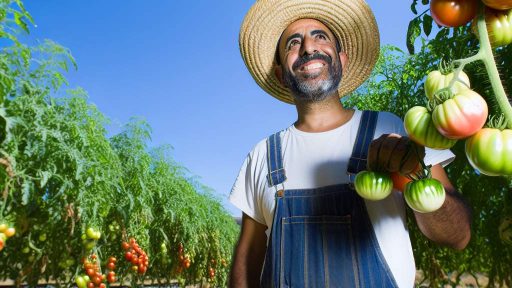Introduction to Food Waste in Agriculture
Food waste in agriculture presents a significant challenge globally.
This issue affects both farmers and consumers alike.
Farmers face losses that impact their profitability.
Moreover, wasted food contributes to environmental degradation.
Understanding the scope of food waste is vital for improvement.
Current State of Food Waste
Approximately one-third of food produced globally gets wasted.
This is particularly significant in the agricultural sector.
Fruits and vegetables often experience the highest levels of waste.
In addition, perishable goods are prone to spoilage during transport.
Farmers struggle with managing supply and demand efficiently.
Causes of Food Waste in Agriculture
Several factors lead to food waste on farms.
First, improper handling during harvesting can cause damage.
Second, a lack of storage facilities exacerbates the problem.
Furthermore, fluctuating market prices discourage overproduction.
Additionally, many crops remain unharvested due to market demands.
Transform Your Agribusiness
Unlock your farm's potential with expert advice tailored to your needs. Get actionable steps that drive real results.
Get StartedImpacts of Food Waste
The impacts of food waste extend beyond economic loss.
It leads to the waste of resources like water and energy.
Also, food waste increases greenhouse gas emissions in landfills.
Consequently, it poses risks to soil health and biodiversity.
In essence, addressing food waste can mitigate these negative effects.
Strategies to Reduce Food Waste in Agriculture
Several strategies can help reduce food waste in agriculture.
Improving logistics and supply chain management is essential.
Farmers can invest in better storage solutions as well.
Also, implementing technology for tracking produce can enhance efficiency.
Moreover, educating farmers about best practices is crucial.
Understanding the Impact of Food Waste on Farm Logistics
Defining Food Waste
Food waste refers to edible food discarded at various supply chain stages.
It occurs on farms, during processing, transportation, and retail environments.
This waste represents lost resources and reduces overall agricultural efficiency.
The Importance of Farm Logistics
Effective farm logistics ensures optimal delivery of products to consumers.
It includes planning, transport, and storage of agricultural goods.
Proper logistics directly influences profitability and sustainability.
Quantifying Food Waste
Globally, approximately one-third of food produced is wasted each year.
This amounts to nearly 1.3 billion tons of wasted food annually.
Farmers often bear the brunt of this waste, affecting their livelihoods.
Effects on Economic Performance
Food waste impacts the bottom line of agricultural businesses.
Costs associated with wasted resources can jeopardize profitability.
Reducing waste can lead to improved financial stability for farms.
Environmental Implications
Food waste contributes significantly to greenhouse gas emissions.
When decomposing, wasted food releases methane, a potent greenhouse gas.
Showcase Your Farming Business
Publish your professional farming services profile on our blog for a one-time fee of $200 and reach a dedicated audience of farmers and agribusiness owners.
Publish Your ProfileThus, minimizing food waste supports environmental sustainability.
Social Considerations
Addressing food waste can enhance food security globally.
Reducing waste means more food is available for those in need.
Communities benefit from greater access to fresh produce.
Role of Technology in Farm Logistics
Technology plays a vital role in improving logistics efficiency.
Data analytics can optimize supply chain management.
Automation enhances speed and accuracy in food processing and delivery.
Strategies for Reducing Food Waste
- Implement better inventory management systems.
- Enhance forecasting methods to match supply with demand.
- Utilize technology for monitoring food conditions during transport.
Training staff on waste reduction techniques can also help.
Engaging with local food banks can redirect excess food efficiently.
Collaborative Approaches
Partnerships within the supply chain can mitigate food waste.
Farmers, distributors, and retailers can unite to tackle this issue.
Sharing best practices and resources fosters a waste-reduction culture.
Assessing the Current State of Food Waste on Farms
Current Food Waste Statistics
Food waste remains a pressing issue in agriculture.
Recent studies show that farms waste nearly 30% of their produce.
This waste occurs at various stages of the supply chain.
Fruits and vegetables are the most commonly wasted items.
Data indicates that over 60% of this waste occurs post-harvest.
Contributing Factors to Waste
Multiple factors contribute to food waste on farms.
Improper handling during harvesting can lead to significant losses.
Poor storage facilities exacerbate the issue.
Temperature fluctuations negatively affect produce freshness.
Many crops spoil before reaching market as a result.
Economic Impact of Food Waste
The economic impact of food waste on farms is substantial.
Farmers face lost revenue from unsold products due to waste.
The costs of disposal can add up significantly.
The loss of resources such as water and labor is equally concerning.
Environmental Consequences of Food Waste
Food waste on farms poses environmental challenges.
Wasted food contributes to greenhouse gas emissions.
When discarded, food decomposes in landfills, releasing methane.
The resources used to produce wasted food are also wasted.
This includes water, energy, and labor, which have far-reaching effects.
Technological Solutions to Reduce Waste
Technology plays a pivotal role in reducing food waste.
Precision farming techniques optimize resource use and reduce waste.
Data analytics helps predict crop yields more accurately.
Innovations in storage methods extend shelf life.
These technologies can significantly enhance farm logistics.
Uncover the Details: Permaculture Practices for Building Resilient Agricultural Ecosystems
Implementing Inventory Management Systems to Track Produce
Effective inventory management is crucial for reducing food waste on farms.
It helps track the movement and status of produce in real-time.
To implement robust systems, farms can utilize digital tools and software.
Showcase Your Farming Business
Publish your professional farming services profile on our blog for a one-time fee of $200 and reach a dedicated audience of farmers and agribusiness owners.
Publish Your ProfileThese tools enable farmers to monitor stock levels accurately.
Additionally, they help in predicting demand trends based on historical data.
Benefits of Inventory Management Systems
Implementing these systems offers several advantages to farmers.
- Enhanced visibility into inventory levels.
- Improved accuracy in order fulfillment.
- Reduced spoilage and waste of perishable goods.
Choosing the Right Software
Selecting suitable software depends on specific farm needs.
Farmers should consider scalability and user-friendliness.
Additionally, integration with existing systems enhances functionality.
It is advisable to evaluate various options before making a decision.
Training Staff for Effective Use
Proper training is essential for maximizing the effectiveness of new systems.
Farm employees should receive hands-on training sessions.
Moreover, ongoing support can help resolve any challenges quickly.
Regular updates on best practices can enhance efficiency.
Analyzing Data for Continuous Improvement
Once the system is in place, data analysis becomes crucial.
Farmers can look for patterns and insights from inventory data.
These insights can lead to informed decisions that reduce waste.
For instance, adjusting planting schedules based on demand can be beneficial.
Gain More Insights: Effective Collaboration With Local Food Producers For Farm-To-Table Pop-Ups
Utilizing Precision Agriculture Technologies for Efficient Resource Use
Understanding Precision Agriculture
Precision agriculture merges technology with traditional farming practices.
This approach enhances efficiency in resource utilization.
Farmers utilize data-driven techniques to make informed decisions.
IoT Devices and Data Collection
Internet of Things (IoT) devices play a vital role in precision agriculture.
Sensors gather crucial data on soil moisture, nutrient levels, and climate conditions.
These devices monitor real-time conditions on the farm.
As a result, farmers can respond promptly to changing circumstances.
Data Analysis and Decision Making
Data analysis enables farmers to interpret collected information effectively.
With advanced software, farmers can predict crop yields and resource needs.
This foresight minimizes waste and optimizes input usage.
Furthermore, it aids in planning irrigation and fertilization schedules.
Implementing Variable Rate Technology
Variable rate technology (VRT) allows farmers to manage their inputs efficiently.
Farmers can apply fertilizers and pesticides at varying rates across fields.
This targeted approach reduces excess application and minimizes waste.
Consequently, it promotes healthier crops and sustainable practices.
Utilizing Drones for Crop Monitoring
Drones provide an aerial view of crop conditions across vast fields.
This technology helps identify underperforming areas quickly.
Farmers can focus their efforts where needed most.
Moreover, drones enable efficient mapping for better resource management.
Economic and Environmental Benefits of Precision Agriculture
Precision agriculture leads to significant cost savings for farmers.
By reducing waste, farms become more economically viable.
This method also promotes environmental sustainability.
In this way, it supports the long-term health of agricultural landscapes.
Uncover the Details: Artisanal Food Production for Small-Scale Farmers
Showcase Your Farming Business
Publish your professional farming services profile on our blog for a one-time fee of $200 and reach a dedicated audience of farmers and agribusiness owners.
Publish Your ProfileEnhancing Supply Chain Partnerships to Minimize Waste
Building Collaborative Relationships
Farmers must collaborate closely with supply chain partners.
These partnerships improve communication and efficiency.
Regular meetings foster trust and transparency among stakeholders.
Strong relationships lead to better coordination of logistics.
Therefore, farmers can anticipate demand more accurately.
Implementing Shared Technology Solutions
Adopting shared technology can significantly reduce waste.
For example, cloud-based inventory management boosts efficiency.
Partnering with technology companies enables real-time tracking of produce.
This ensures optimal storage and reduces spoilage risk.
Additionally, data sharing among partners improves decision-making.
Coordinating Transportation Efforts
Effective transport coordination is crucial to reduce waste.
Farmers should collaborate with logistics providers to optimize routes.
Shared transportation resources lower costs and emissions.
Furthermore, coordinating delivery schedules minimizes delays.
This continuity helps maintain product freshness during transit.
Engaging in Joint Marketing Initiatives
Collaborative marketing can enhance product visibility.
Farmers should partner with retailers to promote fresh produce.
Joint campaigns highlight local offerings and attract consumers.
Such initiatives increase demand and reduce surplus.
As a result, less food goes to waste at farm and market levels.
Monitoring Performance and Outcomes
Regular evaluations identify waste reduction successes.
Farmers and partners should track key performance indicators.
This process reveals areas needing improvement or adjustment.
Feedback loops promote continuous enhancements in logistics.
Ultimately, a commitment to monitoring ensures lasting results.
Delve into the Subject: Farm Fresh Delivery Services for Seasonal Fruits and Vegetables

Training Farm Staff on Best Practices for Waste Reduction
The Importance of Training
Training is essential for effective waste reduction on farms.
It empowers staff with knowledge and skills.
Well-informed employees can actively contribute to sustainability efforts.
Identifying Best Practices
First, identify best practices specific to your farm operations.
Next, incorporate techniques such as efficient inventory management.
Regularly assess equipment maintenance to minimize waste.
Staff should learn to recognize signs of spoilage.
Conducting Training Sessions
Organize regular training sessions for all farm staff.
Consider a mix of hands-on training and theoretical instruction.
Utilize visual aids to enhance understanding of best practices.
Invite experts to share successful case studies.
Creating a Waste Reduction Team
Establish a dedicated team focused on waste reduction practices.
The team should include representatives from various departments.
Encourage collaboration and idea-sharing among members.
Showcase Your Farming Business
Publish your professional farming services profile on our blog for a one-time fee of $200 and reach a dedicated audience of farmers and agribusiness owners.
Publish Your ProfileMonitoring and Evaluating Progress
Set measurable goals for waste reduction efforts.
Regularly review progress towards these goals.
Use feedback to refine training programs and practices.
Celebrate successes to motivate staff and reinforce positive behavior.
Engaging Staff in Continuous Improvement
Encourage staff to share their insights on waste management.
Implement suggestion programs for ongoing improvements.
Foster a culture where staff feel empowered to innovate.
Exploring Composting and Recycling Options for Unsellable Produce
The Importance of Food Waste Reduction
Food waste reduction is critical in modern agriculture.
It directly impacts the environment and economy.
By reducing waste, farms can become more sustainable.
Moreover, this practice contributes to resource conservation.
Composting as a Solution
Composting offers an effective way to handle unsellable produce.
This method transforms waste into valuable soil amendment.
Farmers can create compost from a variety of materials.
- Fruits and vegetables
- Plant trimmings
- Animal manures
- Crop residues
Compost enriches soil by adding nutrients and improving moisture retention.
Additionally, it enhances soil structure and biodiversity.
Establishing a Composting System
A well-organized composting system is essential for effectiveness.
First, farmers should designate a compost area.
This area must be easily accessible and well-drained.
Next, they should maintain a balance of green and brown materials.
- Green materials provide nitrogen.
- Brown materials offer carbon.
Regular turning of the compost pile ensures aeration and speedier decomposition.
Recycling Unsellable Produce
Recycling offers another viable approach to food waste management.
Farmers can recycle produce into by-products for other uses.
This process allows for the creation of value from waste.
Examples of produce recycling include:
- Juicing and creating beverages
- Production of animal feed
- Processing for canned goods
These methods help reduce the amount of waste sent to landfills.
Collaboration with Local Businesses
Collaboration with local businesses can improve recycling efforts.
Farms can partner with food processors and restaurants.
This strategy promotes a circular economy within the community.
Additionally, businesses can benefit from obtaining local produce at lower costs.
Educating Staff and Stakeholders
Education plays a pivotal role in waste reduction efforts.
Farm staff and stakeholders should understand the value of composting and recycling.
Workshops and training sessions can raise awareness and improve practices.
Encouraging participation can enhance overall effectiveness.
Case Studies of Successful Food Waste Reduction Strategies in Farming
Innovative Storage Solutions
One successful strategy for reducing food waste involves enhanced storage solutions.
The Green Valley Farm implemented advanced refrigeration techniques.
This innovation significantly extended the shelf life of fresh produce.
As a result, they reduced spoilage rates by over 30%.
Optimized Supply Chain Management
Efficient supply chain management plays a crucial role in minimizing waste.
Sunset Acres Market adopted real-time inventory tracking systems.
Showcase Your Farming Business
Publish your professional farming services profile on our blog for a one-time fee of $200 and reach a dedicated audience of farmers and agribusiness owners.
Publish Your ProfileThis approach enabled them to better match supply with demand.
Consequently, they experienced a 20% reduction in unsold products.
Collaboration with Local Food Banks
Establishing partnerships with food banks is another effective strategy.
The Fresh Hope Farm regularly donates surplus produce to local shelters.
This initiative not only reduces waste but also benefits the community.
Moreover, it fosters a sense of social responsibility among farmers.
Educational Programs for Farmers
Education plays a vital role in food waste reduction efforts.
The Sustainable Growth Initiative runs workshops for local farmers.
These workshops teach best practices for waste management.
Farmers report improved awareness and implementation of sustainable practices.
Adopting Sustainable Agricultural Practices
Sustainable farming practices significantly reduce food waste over time.
Greenfield Farms transitioned to organic farming methods.
This change decreased chemical usage and improved soil health.
With healthier crops, they report less waste and greater harvest yields.




